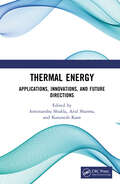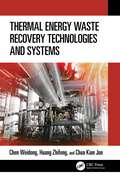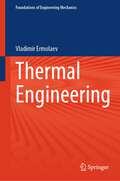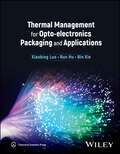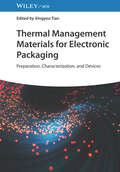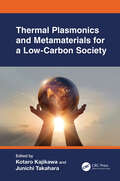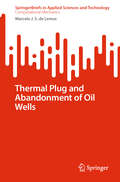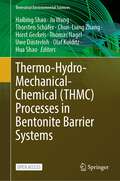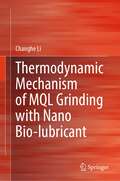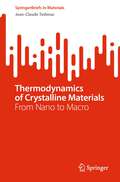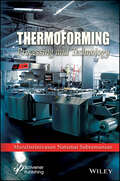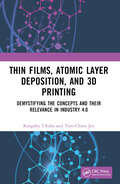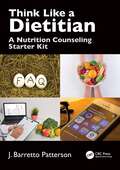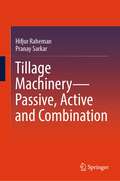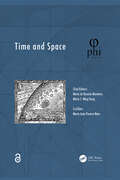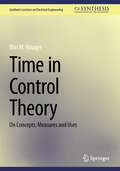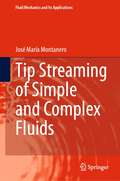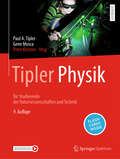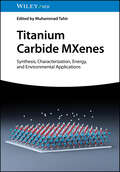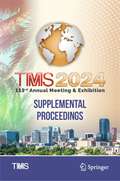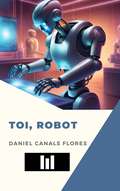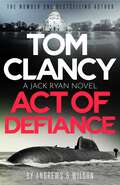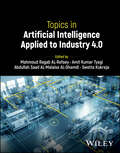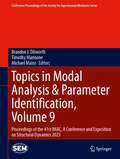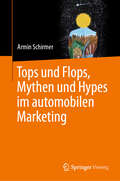- Table View
- List View
Thermal Energy: Applications, Innovations, and Future Directions
by Amritanshu Shukla Atul Sharma Karunesh KantThis book presents the essentials of thermal energy storage techniques along with recent innovations and covers in-depth knowledge of thermal energy applications. Different aspects of thermal energy storage systems are covered, ranging from fundamentals to case studies. Major topics covered include application of thermal energy in water heating, solar cooking and solar pond, thermal energy storage materials for indoor comfort in buildings, thermal management of battery, hydrogen production, reducing carbon footprints, and so forth. Key features: Presents current research and technological updates along with applications and market scenarios in thermal energy storage, thermal management, and applications of thermal energy Explores sensible, latent, and thermochemical energy storage aspects Emphasizes the need and adequate utilization of abundant heat energy for clean energy perspectives Reviews use of thermal energy in hydrogen production, the oil and gas sector, along with market analysis Includes pertinent case studies This book is aimed at researchers and graduate students in energy and mechanical engineering, energy storage, and renewables.
Thermal Energy Waste Recovery Technologies and Systems
by Weidong Chen Zhifeng Huang Kian Jon ChuaThermal Energy Waste Recovery Technologies and Systems comprehensively covers thermal energy recovery technologies and systems. It considers thermal sources, working principles, products, application status, prospects, and challenges. In an effort to achieve energy security, carbon neutralization, and sustainable development, this book discusses waste recovery from thermal energy technologies and systems from varying temperatures. This book features case studies of advanced multi-generation systems for different industrial applications. This book is intended for senior undergraduate and graduate mechanical engineering students taking courses in thermal energy, energy systems, and renewable energy, as well as researchers studying thermal energy utilization, low-carbon technologies, thermal dynamic analysis, and energy system design.
Thermal Engineering (Foundations of Engineering Mechanics)
by Vladimir ErmolaevThis book presents the fundamental principles of thermodynamics and heat transfer, providing a solid foundation for understanding energy systems. From the core concepts of basic thermodynamic state parameters and ideal gases to the complexities of real gases and vapors, this book provides the knowledge to analyze and manipulate energy in various engineering applications. It covers topics such as heat capacity, thermodynamic processes, and the First Law of Thermodynamics, giving insights into how energy is harnessed and utilized. The book explores advanced subjects like second law thermodynamics, circular cycles, and the thermodynamic analysis of thermal power cycle installations, unveiling the intricacies of energy efficiency. The second section of the book shifts focus to heat transfer mechanisms, covering thermal conductivity, convective heat transfer, and thermal radiation. The book is useful to anyone interested in the complexities of energy dynamics in engineering systems.
Thermal Management for Opto-electronics Packaging and Applications
by Xiaobing Luo Bin Xie Run HuThermal Management for Opto-electronics Packaging and Applications A systematic guide to the theory, applications, and design of thermal management for LED packaging In Thermal Management for Opto-electronics Packaging and Applications, a team of distinguished engineers and researchers deliver an authoritative discussion of the fundamental theory and practical design required for LED product development. Readers will get a solid grounding in thermal management strategies and find up-to-date coverage of heat transfer fundamentals, thermal modeling, and thermal simulation and design. The authors explain cooling technologies and testing techniques that will help the reader evaluate device performance and accelerate the design and manufacturing cycle. In this all-inclusive guide to LED package thermal management, the book provides the latest advances in thermal engineering design and opto-electronic devices and systems. The book also includes: A thorough introduction to thermal conduction and solutions, including discussions of thermal resistance and high thermal conductivity materials Comprehensive explorations of thermal radiation and solutions, including angular- and spectra-regulation radiative cooling Practical discussions of thermally enhanced thermal interfacial materials (TIMs) Complete treatments of hybrid thermal management in downhole devices Perfect for engineers, researchers, and industry professionals in the fields of LED packaging and heat transfer, Thermal Management for Opto-electronics Packaging and Applications will also benefit advanced students focusing on the design of LED product design.
Thermal Management Materials for Electronic Packaging: Preparation, Characterization, and Devices
by Xingyou TianThermal Management Materials for Electronic Packaging Practical resource exploring the theoretical and experimental basis as well as solutions for the development of new thermal management materials for electronic packaging Thermal Management Materials for Electronic Packaging: Preparation, Characterization, and Devices provides in-depth and systematic summaries on cutting-edge thermal management materials for high-power density electronic devices, introducing the preparation methods and application scenarios of thermal management materials for electronic packing, covering refinements of thermal conductivity theory and performance prediction models for multiphase composites, and overall focusing on key scientific issues related to the subject, such as the internal interface of new high thermal conductive substrate materials and the mechanism of spatial topology on performance. The text also discusses key issues on the design and preparation of thermal conductive substrate materials with high thermal conductive properties, including their characterization, properties, and manipulation, as well as the latest methods, techniques, and applications in this rapidly developing area. Sample topics covered in Thermal Management Materials for Electronic Packaging include: Basic concepts and laws of thermal conduction, heat conduction differential equation and finite solution, and thermal conductivity of solids Definition and classification of electronic packaging, thermal management in electronic equipment, and requirements of electronic packaging materials Synthesis and surface modification of high thermal conductive filler and the synthesis of substrates and preparation of thermal conductive composites with inorganic ceramic skeleton structure Assembly of thermal conductive materials in different dimensions and preparation of composite materials, and reliability analysis and environmental performance evaluation Thermal Management Materials for Electronic Packaging serves as an ideal reference for researchers and workers in related fields to significantly improve the mechanical and thermal management properties of materials, expand the material selection and design margin of substrates, and develop substrates that meet the application needs of different gradients.
Thermal Plasmonics and Metamaterials for a Low-Carbon Society
by Kotaro Kajikawa Junichi TakaharaIn this edited volume for researchers and students, experts in thermal plasmonics and metamaterials technologies introduce cutting-edge energy and resource conservation techniques and environmentally friendly solutions in areas including energy generation and harvesting and radiative cooling.Through this book, readers will gain an in-depth understanding of the metamaterials and thermal plasmonics technologies used for such devices and the real-world applications of these technologies. This book is divided into three broad sections to address different aspects of these devices. The first section presents research on materials that can control thermal radiation and optical absorption, phase transition materials, and optical design using AI; the second covers research on thermophovoltaic elements, energy harvesting, and radiative cooling; and the third introduces research on photothermal materials’ applications, such as solar steam generation, desalination, recyclable inks, and radiative textiles. Each chapter is authored by an expert whose research is focused on a specific related technology or application. Readers can apply the information in this book to address many common problems related to environment and energy conservation.This book is invaluable for researchers and graduate students working in the fields of nanophotonics, energy, and environmentally friendly solutions, whether they are working on advancing the underlying technologies or expanding the range of usable applications to solve common global problems related to energy use, cooling, and resource consumption.
Thermal Plug and Abandonment of Oil Wells (SpringerBriefs in Applied Sciences and Technology)
by Marcelo J.S. de LemosThis book evaluates a new potential game-change technology where burning a compound known as “thermite” is used to melt the casing, cement and rock forming an impermeable plug within the wellbore. A review on current and emerging technologies is presented. The development of analytical, numerical and experimental tools is documented in separate sections of the book, showing results and discussing the potential for this new technology and its role on the ongoing energy transition process worldwide.
Thermo-Hydro-Mechanical-Chemical (Terrestrial Environmental Sciences)
by Thomas Nagel Olaf Kolditz Hua Shao Haibing Shao Ju Wang Thorsten Schäfer Chun-Liang Zhang Horst Geckeis Uwe DüsterlohThis book is open access book. The collaborative Pilot Project, titled “Comparison of Thermo-Hydro-Mechanical-Chemical (THMC) Processes in Bentonite Barrier Systems”, aims to investigate the fundamentals, conduct laboratory and field experiments, and develop numerical models for barrier systems that ensure the safe isolation of radioactive waste in deep geological repositories. This book compares methodologies and technologies used in experimental laboratory and field research, as well as systems analysis, in a collaborative work of German and Chinese scientists. Both parties have access to exceptional experimental and modelling research capabilities. The Beishan underground research laboratory (URL) is currently under construction in Gansu, China. It will serve as an international collaboration platform for URL research in the future. International cooperation is essential for excellent research and development due to the high cost of scientific programmes and technical operation of URLs, making it a precondition for providing secure solutions. This is important not only for deep geological repositories for radioactive waste disposal but also for other geoenergy applications, such as energy storage and geothermal energy utilization.
Thermodynamic Mechanism of MQL Grinding with Nano Bio-lubricant
by Changhe LiThis book discusses the thermodynamic mechanism of MQL grinding with nano-biological lubricant from the force, heat, surface integrity, and micro-morphology.It makes up the fatal defect of the lack of heat transfer capability of traditional MQL grinding. The machining accuracy, surface quality, especially surface integrity of the workpiece, are significantly improved; at the same time, the service life of the grinding wheel is increased and the working environment is improved.The general scope of the book’s content is the effects of MQL grinding with nano-bio-lubricant on grinding force, thermal mechanism, and surface.It provides a new method of sustainable green grinding for environment-friendly, resource-saving, and energy-efficient utilization and solves the technical bottleneck of the insufficient capacity in MQL heat transfer.
Thermodynamics of Crystalline Materials: From Nano to Macro (SpringerBriefs in Materials)
by Jean-Claude TedenacThis book provides expert treatment of the use of the Calphad calculations for the study of crystal structures and thermodynamics relationships in phase diagram determination. After a short review of the relationships between crystal structures and the thermodynamics of materials, including all possible phase transformations, the book proceeds to a brief discussion of the methods for solving the stability hierarchy of different phases. Coverage includes both theoretical calculations and experimental methods based on classical thermodynamics, with emphasis on the latter. The experimental approach is mainly carried out using heat-exchange data associated with the transition of one form into another. It is demonstrated that the crystallographic properties must be associated with the phase transformations and should be taken into account. The role of X-ray crystallography therein is also discussed. Readers interested in carrying out related research will appreciate the detailed discussion and critical analysis of key results obtained by the author and his colleagues over the past five years.
Thermoforming: Processing and Technology
by Muralisrinivasan Natamai SubramanianThis book is a comprehensive reference manual that contains essential information on thermoforming processing and technology. The field of thermoforming is experiencing rapid development driven by commercial factors; millions of tons of polymers are manufactured for use in various applications, both as commodity and specialty polymers. Building on the previous edition published about ten years ago, this edition includes new, as well as, fully revised chapters and updated information on materials and processes. The book is designed to provide practitioners with essential information on processing and technology in a concise manner. The book caters to both engineers and experts by providing introductory aspects, background information, and an overview of thermoforming processing and technology. The troubleshooting section includes flowcharts to assist in correcting thermoforming processes. >em>Thermoforming: Processing and Technology offers a complete account of thermoplastics, covering properties and forming, with chapters providing perspective on the technologies involved. Readers will find it: serves as a handy knowledge source for professionals who occasionally work on thermoforming projects or need to refresh their knowledge; offers a troubleshooting guide that can help to identify and solve challenges that may arise in thermoforming processes; provides insights into process optimization, helping businesses improve efficiency, reduce waste, and enhance the quality of thermoformed products; acts as a course book to inform students about the thermoforming process. Audience The book will be of interest to mechanical, materials engineers, and process engineers who are involved in designing and optimizing thermoforming processes; professionals in the manufacturing and production industries who use thermoforming as a manufacturing method, such as in the production of plastic packaging, automotive components, and consumer goods; scientists, researchers, and students in plastics/polymer engineering and technology, materials science, polymer technology; professionals responsible for ensuring product quality and compliance with industry standards.
Thin Films, Atomic Layer Deposition, and 3D Printing: Demystifying the Concepts and Their Relevance in Industry 4.0
by Kingsley Ukoba Tien-Chien JenThin Films, Atomic Layer Deposition, and 3D Printing explains the concept of thin films, atomic layers deposition, and the Fourth Industrial Revolution (4IR) with an aim to illustrate existing resources and give a broader perspective of the involved processes as well as provide a selection of different types of 3D printing, materials used for 3D printing, emerging trends and applications, and current top-performing 3D printers using different technologies. It covers the concept of the 4IR and its role in current and future human endeavors for both experts/nonexperts. The book includes figures, diagrams, and their applications in real-life situations. Features: Provides comprehensive material on conventional and emerging thin film, atomic layer, and additive technologies. Discusses the concept of Industry 4.0 in thin films technology. Details the preparation and properties of hybrid and scalable (ultra) thin materials for advanced applications. Explores detailed bibliometric analyses on pertinent applications. Interconnects atomic layer deposition and additive manufacturing. This book is aimed at researchers and graduate students in mechanical, materials, and metallurgical engineering.
Think Like a Dietitian: A Nutrition Counseling Starter Kit
by J. Barretto PattersonWhile courses in nutrition counseling teach providers to listen to their patients, this book gives registered dietitian nutritionists (RDNs) a heads-up on what to listen for, with educational materials that address the everyday challenges many people, hence many RDNs, face.Split into four distinct sections, this book equips readers with comprehensive education and counseling for the most common nutrition referrals.Topics include:- How to structure a nutrition counseling session, from getting a patient to open up to empowering them with information and strategies for self‑care.- Strategies for the provider to address personal challenges such as cultivating empathy, implicit bias, and cultural competence.- Routine eating patterns and challenges reported in nutrition counseling, such as night eating, emotional eating, and more.- Common reasons for referral to a dietitian, and frequently asked questions on topics including diabetes, heart disease, kidney disease, irritable bowel syndrome, and weight counseling.- Special issues in health educationThis book is appealing to both early nutrition professionals and experienced dietitians alike, providing a holistic tool kit for RDNs of all levels of experience.
Tillage Machinery—Passive, Active and Combination
by Hifjur Raheman Pranay SarkarThis textbook comprehensively covers the fundamental concepts of tillage operation, including all the three kinds of tillage implements, viz. passive, active and combination. It discusses functional analysis, principle of operation, and testing of main tillage machinery. This textbook includes the design procedure and numerical examples to reinforce the theoretical concepts. It incorporates a lucid style of writing with easy-to-understand design procedure of different tillage implements. This textbook is highly useful for graduate and postgraduate students studying farm machinery and power engineering, design of agricultural machines, and allied fields.
Time and Space (PHI)
by Maria do Rosário Monteiro Mário S. Ming KongThe texts presented in Proportion Harmonies and Identities (PHI) Time and Space were compiled to establish a multidisciplinary platform for presenting, interacting, and disseminating research. It also aims to foster awareness and discussion on Time and Space, focusing on different visions relevant to Architecture, Arts and Humanities, Design and Social Sciences, and its importance and benefits for the sense of identity, both individual and communal. The idea of Time and Space has been a powerful motor for development since the Western Early Modern Age. Its theoretical and practical foundations have become the working tools of scientists, philosophers, and artists, who seek strategies and policies to accelerate the development process in different contexts.
Time in Control Theory: On Concepts, Measures and Uses (Synthesis Lectures on Electrical Engineering)
by Blas M. VinagreControl Theory is an interdisciplinary field of engineering and mathematics that studies the behavior of dynamic systems with external stimuli and how to modify such behavior through feedback, and the very concept of dynamic system implies the study of how the trajectories of a point in a geometric space evolve in time. Thus, time is at the very foundation of control theory, and its development and achievements are conditioned both by the conception we have of it and by our way of measuring and using it. Following a quasi-chronological order, this work aims to give an overview of how these conceptions and these ways of measuring and using time are reflected in the paths followed by control theory from its origins to the present day.
Tip Streaming of Simple and Complex Fluids (Fluid Mechanics and Its Applications #137)
by José María MontaneroThis book comprehensively describes the tip streaming in simple fluids and those containing surfactants and polymeric molecules. It summarizes the theoretical models and approximations commonly adopted to analyze this phenomenon. It provides relevant experimental results and presents the scaling laws for rationalizing those results. The stability of the flows leading to tip streaming is analyzed theoretically and experimentally. Attention is paid to the effects of surfactant monolayers and viscoelasticity, including solutocapillarity, interfacial elasticity, surface viscosity, and extensional thickening caused by the polymer coil-stretch transition.It also offers an overall perspective of the numerous technological applications of the tip-streaming phenomenon. Remarkable examples are the production of microemulsions and microencapsulation of active agents for the food and pharmacy industries, the atomization of charged liquids for analytical chemistry, and the ejection of ultra-fast and ultra-thin jets for crystallography. Physical mechanisms responsible for the onset of tip streaming driven by hydrodynamic and electrohydrodynamic forces are described. Relevant theoretical and experimental results of the periodic microdripping and continuous microjetting modes of tip streaming produced with microfluidic configurations such as electrospray, flow focusing, coflowing, and selective withdrawal are discussed. The physical mechanisms responsible for the instability of the microjetting mode are studied in detail.The book collects the scaling laws used to predict the outcome of the microfluidic configurations mentioned above. The author combines state-of-the-art experimental results and linear stability analysis to identify the instability mechanisms limiting the applicability of the above-mentioned microfluidic configurations. In this way, the book connects experimental observations with fundamental aspects of tip streaming,bridging the microfluidic and fluid dynamicist communities. The connection between results obtained from the theoretical and experimental approaches will help experimentalists to understand the fundamental aspects of their practical problems. A useful guide for researchers working on hydrodynamic focusing and electrospray.
Tipler Physik: für Studierende der Naturwissenschaften und Technik
by Paul A. Tipler Gene MoscaTipler Physik dient bereits Generationen von Studierenden der Natur- und Ingenieurwissenschaften als Lern-, Lehr- und Nachschlagewerk. Angehende oder sich bereits im Studium befindliche Bachelorstudierende mit Physik, Ingenieurwissenschaften oder verwandter Gebiete, egal ob im Haupt- oder Nebenfach profitieren von ausführlichen und leicht nachvollziehbaren Erklärungen. Schritt für Schritt werden Beispiele vorgerechnet, zusätzlich oft auch mithilfe der Software MATLAB®. Zudem werden die physikalischen Inhalte mit wertvollen Tipps und Tricks vervollständigt. Alle Gebiete der Physik werden behandelt und zwar genau richtig – nicht zu viel um einen guten Einstieg zu ermöglichen und nicht zu wenig, um einen soliden Überblick zu erhalten. Damit ist Tipler Physik ein treuer Begleiter durch das Studium und auch danach. Gleichzeitig trägt das Buch neuen Entwicklungen Rechnung. Digitale Karteikarten, die in dieser Auflage neu hinzugekommen sind, ermöglichen das flexible Lernen und Vertiefen überall. Am Ende jedes Kapitels findet ein Ein- und Ausblick in die aktuelle Forschung statt.Wer im Studium, Schule oder Beruf sich mit physikalischen Fragestellungen befasst, dem sollte Tipler Physik in Bücherregal nicht fehlen: · didaktisch wertvoll aufbereitet und dargestellt· zahlreiche Beispiel- und Übungsaufgaben mit Schritt-für-Schritt Anleitungen bzw. Lösungen· digitale Karteikarten in Form der SN Flashcards· Einführung in MATLAB® anhand konkreter Aufgabenstellungen· bewährte Tipps und Tricks, um nicht in die Fehlerfalle zu geraten· wichtigste Gesetze und Formeln kurz zusammengefasst· übersichtliche und anschauliche Abbildungen· aktuelle Forschungsbeiträge, die in den Kontext zu ihrem Fachgebiet gestellt werden.
Titanium Carbide MXenes: Synthesis, Characterization, Energy and Environmental Applications
by Muhammad TahirTitanium Carbide MXenes Discover the future of solar energy with this introduction to an essential new family of materials MXenes are a recently-discovered family of two-dimensional organic compounds formed from transition metal carbides. Their unique properties, such as high stability and electron conductivity, have made them a sought-after commodity with many industrial applications in cutting-edge industries. In particular, titanium carbide MXenes look poised to have significant applications in the solar energy industry, with potentially revolutionary consequences for the sustainable energy future. Titanium Carbide MXenes offers a thorough and accessible introduction to this family of compounds and their possible applications. It begins by surveying the fundamentals of the MXene groups, before characterizing titanium carbide MXenes and their processes of synthesis. It then moves on to discuss applications, current and future. The result is a must-read for researchers and professionals looking to synthesize and construct these materials and apply them in sustainable industry. Titanium Carbide MXenes readers will also find: Detailed treatment of MXenes including nitrides composites, perovskites composites, and more Discusses applications in photocatalytic CO2 reduction, hydrogen production, water splitting, and more Roughly 100 figures illustrating key concepts Titanium Carbide MXenes is a must-have for materials scientists, catalytic chemists, and scientists in industry.
TMS 2024 153rd Annual Meeting & Exhibition Supplemental Proceedings (The Minerals, Metals & Materials Series)
by The Minerals, Metals & Materials SocietyThis collection presents papers from the 153rd Annual Meeting & Exhibition of The Minerals, Metals & Materials Society.
Toi, robot
by Daniel Canals FloresToi, robot, Il est un sérieux avertissement pour l’humanité. En écrivant cette histoire, un frisson m'a traversé l'âme: l'acronyme I.A. (Intelligence Artificielle) correspondent à celles du génie robotique incontesté Isaac Asimov. Le professeur en était-il conscient? Ce livre est un hommage à son œuvre et à sa vision futuriste inquiétante. La quatrième révolution industrielle et l'égoïsme de quelques-uns engendreront le monstre qui finira par dominer l'Univers et détruire l'espèce humaine...
Tom Clancy Act of Defiance: The unmissable gasp-a-page Jack Ryan thriller (Jack Ryan #24)
by Brian Andrews Jeffrey WilsonFOR JACK RYAN, THE GREATEST THREAT LURKS BENEATH THE WAVES . . . AGAIN When a Russian superweapon is let loose under the waves, it's up to President Jack Ryan to find a countermove in the latest entry in this #1 New York Times bestselling series.US intelligence is reporting turmoil in the Russian navy. Their deadliest submarine, the Belgorod, has unexpectedly launched. Who authorised the departure? What mission is it on? And, most disturbing of all, what weapons do the giant doors on the sub's bow hide?It's been four decades since a similar incident with the Soviet sub, Red October, ended happily, thanks to a young CIA analyst named Jack Ryan.Now, President Jack Ryan finds himself with fleets of ships, squadrons of jets, and teams of SEALs at his command, but what he doesn't have is insight into the plans of the Belgorod's commander. It falls to a younger generation of Ryans to do the dangerous work that will reveal that information.But there's always a price to be paid. When the final moments tick away, will Jack Ryan have to choose between the safety of his country and the safety of his child?___________PRAISE FOR TOM CLANCY'Constantly taps the current world situation for its imminent dangers and spins them into an engrossing tale'NEW YORK TIMES'Exhilarating. No other novelist is giving so full a picture of modern conflict'SUNDAY TIMES'A brilliantly constructed thriller that packs a punch'DAILY MAIL'Heart-stopping action . . . entertaining and eminently topical'WASHINGTON POST
Topics in Artificial Intelligence Applied to Industry 4.0
by Mahmoud Ragab AL-Refaey Amit Kumar Tyagi Abdullah Saad AL-Malaise Swetta KukrejaTopics in Artificial Intelligence Applied to Industry 4.0 Forward thinking resource discussing emerging AI and IoT technologies and how they are applied to Industry 4.0 Topics in Artificial Intelligence Applied to Industry 4.0 discusses the design principles, technologies, and applications of emerging AI and IoT solutions on Industry 4.0, explaining how to make improvements in infrastructure through emerging technologies. Providing a clear connection with different technologies such as IoT, Big Data, AR and VR, and Blockchain, this book presents security, privacy, trust, and other issues whilst delving into real-world problems and case studies. The text takes a highly practical approach, with a clear insight on how readers can increase productivity by drastically shortening the time period between the development of a new product and its delivery to customers in the market by 50%. This book also discusses how to save energy across systems to ensure competitiveness in a global market, and become more responsive in how they produce products and services for their consumers, such as by investing in flexible production lines. Written by highly qualified authors, Topics in Artificial Intelligence Applied to Industry 4.0 explores sample topics such as: Quantum machine learning, neural network implementation, and cloud and data analytics for effective analysis of industrial data Computer vision, emerging networking technologies, industrial data spaces, and an industry vision for 2030 in both developing and developed nations Novel or improved nature-inspired optimization algorithms in enhancing Industry 5.0 and the connectivity of any components for smart environment Future professions in agriculture, medicine, education, fitness, R&D, and transport and communication as a result of new technologies Aimed at researchers and students in the interdisciplinary fields of Smart Manufacturing and Smart Applications, Topics in Artificial Intelligence Applied to Industry 4.0 provides the perfect overview of technology from the perspective of modern society and operational environment.
Topics in Modal Analysis & Parameter Identification, Volume 9: Proceedings of the 41st IMAC, A Conference and Exposition on Structural Dynamics 2023 (Conference Proceedings of the Society for Experimental Mechanics Series)
by Brandon J. Dilworth Timothy Marinone Michael MainsTopics in Modal Analysis, Testing & Parameter Identification, Volume 9: Proceedings of the 41st IMAC, A Conference and Exposition on Structural Dynamics, 2023, the ninth volume of ten from the Conference brings together contributions to this important area of research and engineering. The collection presents early findings and case studies on fundamental and applied aspects of Modal Analysis, Modal Testing and Modal Parameter Identification including papers on:Analytical MethodsModal ApplicationsBasics of Modal AnalysisExperimental TechniquesOperational Modal AnalysisModal Parameter IdentificationNovel TechniquesRotating MachineryAdditive Manufacturing ApplicationsBiomedical Applications
Tops und Flops, Mythen und Hypes im automobilen Marketing
by Armin SchirmerDas Buch analysiert und pointiert Tops und Flops im Marketing der Automobilindustrie sowie aktuelle Mythen und Hypes von der Klimawende über die Verkehrswende bis zu Carsharing und dem ‚Purpose‘ von Automobilunternehmen. Dies erfolgt zum einen auf wissenschaftlicher Basis mit aktuellen Daten und Fakten, zum anderen ist das Buch meinungsstark und nennt bekannte Beispiele beim Namen. Zahlreiche Fotos, Abbildungen und Tabellen machen das Ganze anschaulich.
